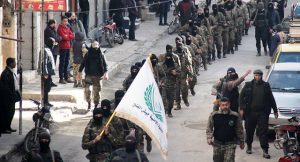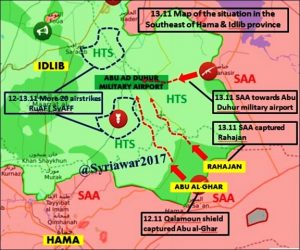LUC MICHEL (ЛЮК МИШЕЛЬ) & EODE/
Luc MICHEL pour EODE/
Quotidien géopolitique – Geopolitical Daily/
2018 01 18/
“The Astana process is on the verge of collapse, as Turkey and Russia are lining up on opposite sides in Idlib, which may prove to be the decisive battle in the Syria war”
– al-Monitor (January 14, 2018).
At the heart of the conflict in Syria, this war started in 2011, which ends, and already goes to a second war, the opportunistic and ambiguous position of Erdogan, shared between his neo-Ottoman geopolitical project (which presupposes the American alliance and the defeat of Damascus) and the immediate strategic demands of Kurdish containment (1), have been the subject of much debate among the experts.
Here is an interesting analysis of ‘al-Monitor’ that goes in the direction of my own analyzes, on the Levantine duplicity of the Turkish regime and its opportunistic poker shots. Here are the facts of Ankara’s complicity with the jihadists (so-called “moderates”) of the al-Nusra Front (al-Qaeda in Syria) in Idlib. Those precisely who have just tried to attack drones against Russian bases in Syria, with the help of an American radar aircraft of the type “Poseidon” …
* Résumé français :
Au coeur du conflit en Syrie, de cette guerre commencée en 2011, qui se termine, et va déjà vers une seconde guerre, la position opportuniste et ambigüe d’Erdogan, partagé entre son projet géopolitique néo-ottoman (qui suppose l’alliance américaine et la défaite de Damas) et les exigences stratégiques immédiates du “containment” des kurdes, fait l’objet de longs débats parmi les experts.
Voici une intéressante analyse de ‘al-Monitor’ qui va dans le sens de mes propres analyses, sur la duplicité levantine du régime turc et ses coups de poker opportunistes. Voici les faits de la complicité d’Ankara avec les djihadistes (dits “modérés”) du Front al-Nosra (al-Qaida en Syrie) à Idlib. Ceux là précisément qui viennent de tenter l’attaque des drônes contre les bases russes en Syrie, avec l’aide d’un avion-radar américain du type “Poséidon” …
“TURKEY’S UNEASY TIES WITH HAYAT TAHRIR AL-SHAM …
IS TURKEY ALIGNED WITH AL-QAEDA AFFILIATE IN IDLIB?”
AL-MONITOR (JAN. 14, 2018)
* Excerpt 1/
“Turkey and Russia are lining up on opposite sides in Idlib”:
“The Astana process is on the verge of collapse, as Turkey and Russia are lining up on opposite sides in Idlib, which may prove to be the decisive battle in the Syria war.
Syria’s military operations in Idlib “are making Turkey so tense that it summoned the ambassadors of Iran and Russia and warned them that the Syrian army’s moves violate the accord reached in Astana, Kazakhstan, which provides for de-escalation zones guaranteed by Iran, Russia and Turkey,” writes Fehim Tastekin.
Moscow has intimated that drones that targeted Russian facilities in Khmeimim and Tartus on Jan. 6 originated from areas controlled by Turkish-backed “moderate” opposition groups. Ankara has denied the charge, arguing that the attacks were the result of terrorist forces gaining a foothold in the region as a result of the Syrian offensive.
Turkey is the main backer of the “moderate” Free Syrian Army (FSA). Power in Idlib also rests with Hayat Tahrir al-Sham (2), the jihadi group that is linked with al-Qaeda and includes fellow travelers from Ahrar al-Sham (3), which lost out in the power struggle with Hayat Tahrir al-Sham. Both groups see the future of Syria as based on Islamic law, and their rule in Idlib has been characterized by tyranny and torture, as documented by Amnesty International and reported in this column.
In Ankara’s score, the Syrian offensive in Idlib is a violation of the cease-fire agreement and a threat to fragile peace negotiations. “Turkey’s sharp reaction to the uptick in fighting suggests that the agreement struck in Astana, at least as it relates to Idlib, is unraveling,” writes Amberin Zaman. “The immediate trigger appears to be the series of mysterious drone attacks on Russian military bases in Syria’s Latakia province since the start of the year. Moscow apparently believes Turkey did not stick to its side of the bargain either, amid accusations that Turkish forces chose to coexist rather than curb when they moved into Idlib last October as peace monitors.”
As Syrian forces advance, and come into conflict with the FSA and Hayat Tahrir al-Sham, Turkey finds itself in an uneasy alignment with Hayat Tahrir al-Sham, putting it at odds with both Russia and Iran. “The struggle at Idlib is considered by many to be the last act of the war against a jihadi group that is basically controlled by Hayat Tahrir al-Sham under the leadership of al-Qaeda-linked Jabhat Fatah al-Sham,” writes Tastekin. “Hayat Tahrir al-Sham labels the Astana and Geneva peace processes as treason, so the cease-fire Russia formulated excludes Hayat Tahrir al-Sham as well as the Islamic State (IS). From the outset, Russia said the cease-fire covers only ‘moderate’ opposition groups; operations against Hayat Tahrir al-Sham and IS will not cease. Turkey, on the other hand — despite its approval of the Astana process — decided to place Hayat Tahrir al-Sham in a different category. Ankara first tried to reshape that organization as it had earlier with Ahrar al-Sham. When that didn’t work, Turkey tried to split Hayat Tahrir al-Sham. When that didn’t work as well, Ankara accepted the facts of life and decided to cooperate”.”
* Excerpt 2/
The top priority for Turkey is breaking the power of the YPG militia:
“The top priority for Turkey is breaking the power of the Syrian Kurdish People’s Protection Units (YPG) militia, which it considers a terrorist organization, linked to the Kurdistan Workers Party (PKK) in Turkey. “If the terrorists in Afrin don’t surrender we will tear them down,” Turkish President Recep Tayyip Erdogan said Jan. 13.
“According to Hayat Tahrir al-Sham sources,” Tastekin reports, “there were three conditions to allow Turkey’s army to enter the area without encountering any opposition. One was that the target would be Afrin, where the Kurds have declared autonomy. A second would be that there would be no operation against groups controlling Idlib. The third was that local groups affiliated with Turkey’s Operation Euphrates Shield would not enter the area. … Turkey’s deployment — approved and escorted by Hayat Tahrir al-Sham — was not compatible with Iran’s and Russia’s definition of the de-escalation zone. Turkey was indirectly providing a shield for the organizations already dominating Idlib.”
In addition to divisions among the Astana parties, Turkey’s fractures with Hayat Tahrir al-Sham sparked divisions within the jihadi group itself. “In such a risky atmosphere, Ankara is hoping to hold on to Idlib and the triangle of al-Bab, Jarablus and Azaz that Turkey had secured in Operation Euphrates Shield, to use them as a card against Damascus in a settlement process,” Tastekin concludes. “Such a card would have serious ramifications for the fate of the Syrian president and the future of the Kurds as they seek to build their autonomy in the north. Until he gets the concessions he seeks for these two key issues, Erdogan doesn’t want the Syrian army to approach the Turkish border and face Turkish troops”.”
NOTES:
(1) See (in French): LUC MICHEL EN DEBAT SUR LE WEBSITE ‘LES 7 DU QUEBEC’ : ‘SYRIE, D’UNE GUERRE À L’AUTRE L’AGRESSION NE CESSE PAS!’ …
(2) Hay’at Tahrir al-Sham, “Organization for the Liberation of the Levant” or “Levant Liberation Committee”), commonly referred to as Tahrir al-Sham and abbreviated HTS, also known as “al-Qaeda in Syria”, is an active Salafist jihadist militant group involved in the Syrian War. The group was formed on 28 January 2017 as a merger between Jabhat Fateh al-Sham (formerly al-Nusra Front), the Ansar al-Din Front, Jaysh al-Sunna, Liwa al-Haqq, and the Nour al-Din al-Zenki Movement. After the announcement, additional groups and individuals joined. The merger is currently led by Jabhat Fatah al-Sham and former Ahrar al-Sham leaders, although the High Command consists of leaders from other groups. Many groups and individuals defected from Ahrar al-Sham, representing their more conservative and Salafist elements. Currently, a number of analysts and media outlets still continue to refer to this group by its previous names, al-Nusra Front, or Jabhat Fateh al-Sham.
Despite the merger, Tahrir al-Sham has been accused to be working as al-Qaeda’s Syrian branch on a covert level. However, Tahrir al-Sham has officially denied being part of al-Qaeda and said in a statement that the group is “fully independent and doesn’t represent any foreign body or organization”. Furthermore, some factions such as Nour al-Din al-Zenki, which was part of the merger, were once supported by the US. Some analysts reported that the goal of forming Tahrir al-Sham was to unite all groups with al-Qaeda’s extreme ideology under one banner, and to obtain as many weapons as possible. They also reported that many of the former Jabhat Fateh al-Sham fighters still answered to al-Qaeda, and held an increasing amount of sway over the new group. It has also been claimed that despite the recent formation of Tahrir al-Sham, the new group secretly maintains a fundamental link to al-Qaeda, and that many of the group’s senior figures, particularly Abu Jaber, held similarly extreme views. Russia claims that “Tahrir al-Sham shares al-Nusra Front’s goal of turning Syria into an Islamic emirate run by al-Qaeda.”
(3) ‘Harakat Ahrar ach-Cham al-Islamiyya’, initialement ‘Kataib Ahrar ach-Cham’ (‘Islamic Movement of the Free Men of the Levant’), commonly referred to as ‘Ahrar al-Sham’, is a coalition of multiple Islamist and Salafist units that coalesced into a single brigade and later a division in order to fight against the Syrian Government led by Bashar al-Assad during the Syrian War. Ahrar al-Sham had 10,000 to 20,000 fighters, which at the time made it the second most powerful unit fighting against al-Assad, after the Free Syrian Army. It was the principal organization operating under the umbrella of the ‘Syrian Islamic Front’ and was a major component of the Islamic Front. With an estimated 20,000 fighters in 2015, Ahrar al-Sham became the largest rebel group in Syria after the Free Syrian Army became less powerful. Ahrar al-Sham and Jaysh al-Islam are the main rebel groups supported by Turkey and Saudi Arabia. The group aims to create an Islamic state under Sharia law, and in the past has cooperated with the al-Nusra Front, an affiliate of al-Qaeda. While both are major rebel groups with similar Salafist ideologies active in the Idlib region, Ahrar al-Sham is not to be confused with Tahrir al-Sham (al-Nusra Front and associates), its main rival and former ally. ‘Ahrar al-Sham’ use both Syrian opposition flag (the flag of the French coloniaml mandate before 1945) and salafist black flag.
(Sources: al-Monitor – EODE Think-Tank)
Photo:
Jihadists of Hayat Tahrir al-Sham (formerly Jabbat al-Nbusra), the jihadi group that is linked with al-Qaeda.
LUC MICHEL (ЛЮК МИШЕЛЬ) & EODE
* PAGE SPECIALE Luc MICHEL’s Geopolitical Daily https://www.facebook.com/LucMICHELgeopoliticalDaily/
________________
* Luc MICHEL (Люк МИШЕЛЬ) :
WEBSITE http://www.lucmichel.net/
PAGE OFFICIELLE III – GEOPOLITIQUE
https://www.facebook.com/Pcn.luc.Michel.3.Geopolitique/
TWITTER https://twitter.com/LucMichelPCN
* EODE :
EODE-TV https://vimeo.com/eodetv


